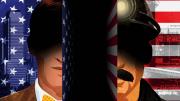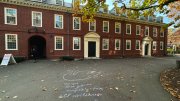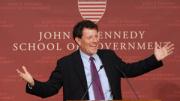The gap between coastal elites and America’s white working class has been growing for decades, but in the wee hours of November 9, America’s intellectuals discovered that they had been drowned in a tidal wave of anger and frustration. Harvard students may have supported Hillary Clinton over Donald Trump by 80 percent to 6 percent, and 91 percent of Harvard faculty members’ campaign contributions may have gone to Clinton—but none of that mattered as non-college-educated whites delivered a convincing electoral college victory to a man whom many elites abhorred. If selective colleges are the place where smart high-school kids begin to enjoy the “revenge of the nerds,” election day 2016 was something like the very opposite: the comeuppance of the intelligentsia.
For some, the gap exposed by the election has given rise to understandable feelings of moral superiority toward benighted Trump voters. Their candidate ran a hideous campaign in which he advocated banning Muslims from entering the country, claimed a federal judge was inevitably biased because of his Mexican-American heritage, and was exposed as bragging on camera about his ability to commit sexual assault. For many (myself included), voting for Trump was unthinkable.
Yet millions of our fellow Americans did so and, in a democracy, it is critical to understand why. Racism and sexism have always been potent forces in American history, and there was plenty of evidence of both at play in the election. But as commentator Van Jones notes, people voted the way they did “for complex reasons.” The idea “that if you voted for a bigot, you are a bigot,” is an oversimplification, he says. What explains the Barack Obama supporters who switched to Trump? Were the millions of female Trump voters endorsing sexism? Why were white workers so open to an appeal that they were “forgotten” by the political class? Might white working-class voters have noticed, as journalist Harold Meyerson wrote, that “deplorable” is a term Hillary Clinton ascribed to many of them, but never to Wall Street bankers who savaged the economy?
Robert Coles: Empathy for the White Working Class
It behooves the academy to understand the behavior of white working people. In a system of self-governance that values the opinions of everyday people, it is important to know why so many Americans were apparently so frustrated that they were willing to vote for a candidate bent on blowing up the system.
A good place to start is within the academy itself. No one there has promoted the understanding of Middle Americans more than Robert Coles, the brilliant professor of psychiatry, now emeritus, who began teaching at Harvard in 1965. Coles is well known for his Pulitzer Prize-winning books on Children of Crisis and has received the Presidential Medal of Freedom, but his greatest talent has been his ability to research and write about class in America in a way that connects people across color lines.
The son of a Midwestern mother and an English immigrant father, Coles grew up with both an American sense of racial injustice, in a country whose original sin is slavery, and a British sense of class inequality, rooted in that nation’s feudal history. His father, Coles told me a number of years ago, had been raised in a society where people “knew what class they belonged to, and they used that word again and again and again, with much more sociological accuracy than we’re inclined to find in ourselves in this country.”
Coles graduated from Harvard College in 1950, went to medical school at Columbia, and ultimately specialized in child psychiatry. In the early 1960s, after a stint in Mississippi as an Air Force doctor, he became intrigued by the battles over school desegregation. He came to fame when he wrote an article for The Atlantic that provided a moving account of his interactions with a courageous six-year-old black girl, Ruby Bridges, who helped integrate the New Orleans schools in the face of virulent white hostility. He was particularly struck that as Ruby was tormented by the most hateful chants from white parents, she would silently pray for them. Coles later remarked that Ruby’s parents, who had little formal education, had raised their child to have more empathy and moral strength than many children of the highly educated.
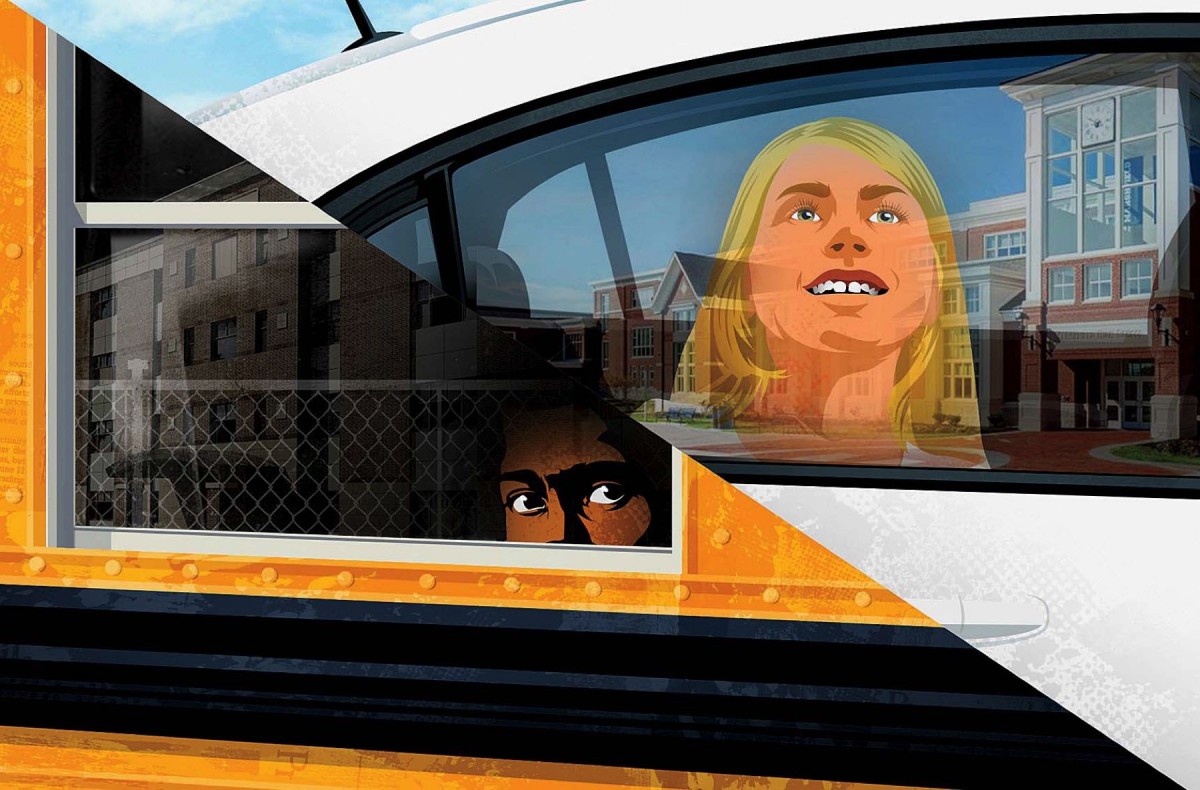
Illustration by Taylor Callery
In 1968, Coles served as informal adviser to liberal hero Robert F. Kennedy ’48 in his quest for the Democratic presidential nomination. (He wrote the last speech the candidate delivered before his assassination.) Coles was fascinated by the way Kennedy was able to connect simultaneously with black Americans, who appreciated his passionate support for civil rights, and with working-class whites, some of whom had voted for George Wallace for president four years earlier, by appealing to shared economic interests. He told the candidate, “There is something going on here that has to do with real class politics.” Kennedy appealed to lower-middle-income whites, Coles told me, because they thought, “This guy isn’t going to use us to show those rich Harvard-types what a great guy he is [by labeling us as backward]. He may be for them [African Americans], but he’s for us, too.”
A few years before Kennedy’s assassination, Coles’s research had taken a controversial turn. His writings about Ruby Bridges and his association with Kennedy earned liberal plaudits—but his decision to spend time with white blue-collar families who felt left out and ignored was not so well received by the liberal intelligentsia. In the early 1970s, he published The Middle Americans: Proud and Uncertain, which explained, with deep empathy, the experiences of white firefighters, factory workers, shopkeepers, and farmers. He was vilified for his new research by many of his friends in academia, who could not understand why Coles would devote his considerable talents to a group of Americans whom many progressives viewed as reactionary, racist, and sexist.
Then, in the mid 1970s, Coles crossed the line for many Harvard liberals again. When Boston was aflame over court-ordered busing to desegregate its public schools, most of the Harvard community was understandably aghast as white working-class people threw bricks at buses carrying black students to white schools. Coles condemned the violence but caused an enormous stir when he said that he understood white working-class resentment of compulsory busing policies that left out wealthier surrounding communities such as Wellesley, Newton, and Cambridge.
In October 1974, The Boston Globe devoted nearly the entire op-ed page to an interview with him. “I think the busing is a scandal,” he said. “I don’t think it should be imposed like this on working-class people exclusively. It should cross these lines and people in the suburbs should share in it….” Coles argued that the “ultimate reality is the reality of class….That’s the real struggle here.” Working-class whites and blacks, he said, have “gotten a raw deal….Both groups have been ignored. Both of them are looked down upon by the well-to-do white people.”
Coles didn’t romanticize blue-collar whites in Boston; they were known, he said, to hurl racial epithets not used in polite society. But he added: “I don’t think that all these experts…these various social scientists and those in favor of integration like myself should be in a position to deliver sermons to the people of Boston…until we have been made a part of all of this.” Of people living in wealthy suburbs, he said, “Their lives are clean and their minds are clean. And they can afford this long, charitable, calm view. And if people don’t know that this is a class privilege, then, by golly, they don’t know anything.”
Two decades later, Coles recalled that his comments about busing and his empathetic treatment of working-class whites in The Middle Americans constituted the “two times in my life when I got into a lot of trouble for what I’ve said.” He continued, “I’ve never heard some of the scorn that can be mobilized against people expressed so vividly as on both of those occasions from people who take great pains—and commendably so—to try to understand people of different racial backgrounds [emphasis added]. The same people can speak about working-class people of their own race with no great charity and often times no great effort at understanding.”
As an undergraduate in the early 1980s, I soaked up Coles’s thinking on race and class in his legendary course, “The Literature of Social Reflection,” in which we studied authors from Charles Dickens and Ralph Ellison to George Orwell and Flannery O’Connor. Dubbed “Guilt 101,” the course was easy for cynics to ridicule, but students flocked to it. I well remember the class during which a member of The Harvard Lampoon burst into the room and, as part of an initiation rite, began imitating his style of lecturing. Coles asked the student to leave and then stood, in pained silence, clearly distressed. After a few moments, a student yelled out from the back row, “We love you, Doc.” Four hundred students jumped to their feet and began to clap furiously.
I went on to take Coles’s course on “The Literature of Christian Reflection,” which stood out at secular Harvard, and came to know him better when we had long discussions for my senior thesis on Robert Kennedy’s ability to reach working-class whites and blacks in his 1968 presidential campaign. As a law student, I took his “Dickens and the Law” course, which used novels such as Bleak House and Great Expectations to ask important questions about the role of lawyers in society. He later wrote the foreword to my 1992 book, Broken Contract: A Memoir of Harvard Law School, which played out those larger themes. His call to pay attention to larger class issues that affect black and white alike has been the touchstone for my writing during the last 30 years as I’ve tried to apply civil-rights remedies to larger issues of class inequality—in K-12 education, higher education, and employment law.
In writing a book on school integration, I discovered that Coles’s insight about Boston touched on an important educational truth: the socioeconomic status of a child’s classmates has a much more profound impact on student achievement than his classmates’ race. (Today, 100 school districts and charter schools educating 4.4 million students in 32 states are pursuing integration policies by socioeconomic status.) In another of my books, Coles’s lens prompted me to suggest that just as the Civil Rights Act protects against discrimination based on race and ethnicity, so it should provide similar protections to people of all races who are trying to organize a union in order to join the middle class. The neglected injuries of class that Coles emphasized also helped me think through my books on affirmative action and legacy preferences in college admissions (see below).
Inequality in Today’s Academy
Today, a modest number of Harvard professors are writing powerfully about class, including William Julius Wilson, Matthew Desmond, Robert Putnam, and Theda Skocpol. Elsewhere, Nancy Isenberg of Louisiana State University recently explored the impact of economic inequality in White Trash: The 400 Year Untold History of Class in America, and Berkeley’s Arlie Hochschild wrote of conservative whites in Strangers in Their Own Land: Anger and Mourning on the American Right.
But these are the outliers. Among sociologists, race and gender have swamped class. The University of Illinois’s Walter Benn Michaels has observed, “Although no remark is more common in American public life than the observation that we don’t like to talk about race, no remark... is more false.” He explains, “|I]n fact, we love to talk about race. And, in the university, not only do we talk about it; we write books and articles about it, we teach and take classes about it, and we arrange our admissions policies in order to take it into account.” In part, Michaels suggests, we talk about race to avoid talking about class.
Labor law, for example, grapples with the great issue of class inequality. Teaching the subject was a smart move for rising young Harvard academics like Derek Bok and Archibald Cox. But in recent decades, Harvard labor-law professors took to spending a lot of time on other topics such as sports law. If anything, many professors see labor unions as a threat, as graduate students seek to organize for better treatment.
The irony is that just as class inequality was becoming a less salient topic in the academy, issues of class were becoming increasingly urgent in American society. If you ask Americans what development they are most proud of during the last half-century, many will suggest the advance of the civil-rights revolution. To be sure, not enough progress has been made, as recent events remind us—and women, too, continue to face serious bias. But it is undeniable, as Putnam notes in his recent Our Kids, that over the past 50 years, “the power of race, class and gender to shape life chances in America has been substantially reconfigured.”
Racial intermarriage, for example, has become more common—but marriage across class lines is less frequent than it once was. Where single-parent household formation used to be heavily predicted by race, now it is increasingly associated with social class. Housing segregation by race is slowly declining, while such segregation by income is on the rise. And the achievement gap between black and white students has slowly diminished, but during the past 25 years, the income-achievement gap has widened by 30 percent.
Unconscionable racial gaps in life expectancy remain, but in recent years, the big news, as reported by Princeton’s Angus Deaton and Anne Case, is that life expectancy has fallen for working-class whites, reflecting the ravages of alcoholism, drug overdoses, and suicide. When the findings were released, it is telling that some liberals immediately found an uncharitable racial explanation: in “What’s Eating White America?” for instance, Jared Keller wrote about Deaton and Case’s findings: “For poor whites who lacked much economic power in the first place, the ascendency of women and minorities is particularly alarming (just look at the racial anxiety of the Tea Party.)” Apparently, we are to believe, white working-class people are slowly killing themselves because of the gains of women and minorities.
Elite disdain of white working-class people has only increased since the 2016 election. The analysis of liberal pundits, as Barbara Ehrenreich notes, has boiled down to: “What’s wrong with them?...Why do they believe Trump’s promises? Are they stupid or just deplorably racist?” After the election, for example, the Daily Kos published a particularly cruel article entitled, “Be happy for coal miners losing their health insurance. They’re getting exactly what they voted for.”
The reaction to white working-class Trump voters raises a profound question: why do white intellectual liberals, privileged by both race and class, seem to have so much more race guilt than class guilt? And what is to be done about the liberal academic blind spot regarding white working-class people?
The Elite Academy: Who Belongs?
Changing policies to genuinely consider class disadvantage in admissions is an important place to start. In the context of race relations, Harvard professor Gordon Allport’s well-known “contact hypothesis” suggested that prejudice is reduced when people of different races come into contact on a basis of equal status. Exposing professors and fellow students to more bright young men and women of working-class backgrounds may deepen empathy and reduce the likelihood that academics will stereotype blue-collar people as stupid or backward.
Harvard, to its enduring credit, has made great strides on racial diversity. The admitted class of 2020 is 13.7 percent African American, 22.1 percent Asian American, 12.6 percent Hispanic, and 2.6 percent Native American or Pacific Islander.
But its economic profile looks nothing like America’s. Despite concerted efforts to boost financial aid in recent years, enormous gaps remain. Looking at individuals born between 1981 and 1991, Raj Chetty of Stanford and his colleagues found that Harvard students from the most affluent 10 percent of the population outnumbered those from the bottom 90 percent. Indeed, by income, about as many Harvard students came from the top 1 percent as from the bottom 60 percent.
Elite higher education as a whole faces the same problem. As Richard Sander of UCLA Law School notes, the underrepresentation of low-income students at selective law schools is “comparable to racial representation fifty years ago, before the civil rights revolution.” In the recent best seller Hillbilly Elegy, J.D. Vance articulated how out of place he felt as a low-income white law student at Yale: “Very few people at Yale Law School are like me. They may look like me, but for all of the Ivy League’s obsession with diversity, virtually everyone—black, white, Jewish, Muslim, whatever—comes from intact families who never worry about money.”
The virtual absence of working-class students on elite campuses has consequences broader than those for the students themselves. It is detrimental to the research conducted by professors. It makes it easier for academics to engage in lazy stereotypes about groups of students they do not know. It also makes it more likely that faculty will avoid talking about hard issues of class. Moreover, because faculty members themselves are drawn mostly from the ranks of elite colleges, the paucity of working-class students in one generation becomes a paucity of professors with working-class origins in the next.
The economic segregation of selective universities is the highly predictable result of a number of admissions policies that generally exclude working-class students, particularly those who are white. While holistic admissions policies are supposed to include consideration of economic hurdles that students have overcome, careful analysis by the late William Bowen, a former Princeton president, published in 2005 found that elite colleges do not in fact weight economic disadvantage in the way they do other factors. Looking at 13 selective colleges (including Harvard), Bowen found that for a student with a given academic profile, being a recruited athlete boosted one’s admissions chances by 30.2 percentage points. Being an underrepresented minority increased one’s chances by 27.7 percentage points; a legacy, by 19.7 percentage points; a first-generation college student, by 4.1 percentage points; and in the bottom income quartile, not at all. Another study of elite private colleges, by Princeton’s Thomas Espenshade and his coauthor, Alexandria Radford, found that, holding academic ability constant, upper-middle class whites were three times more likely than low-income whites to be admitted to selective private colleges.
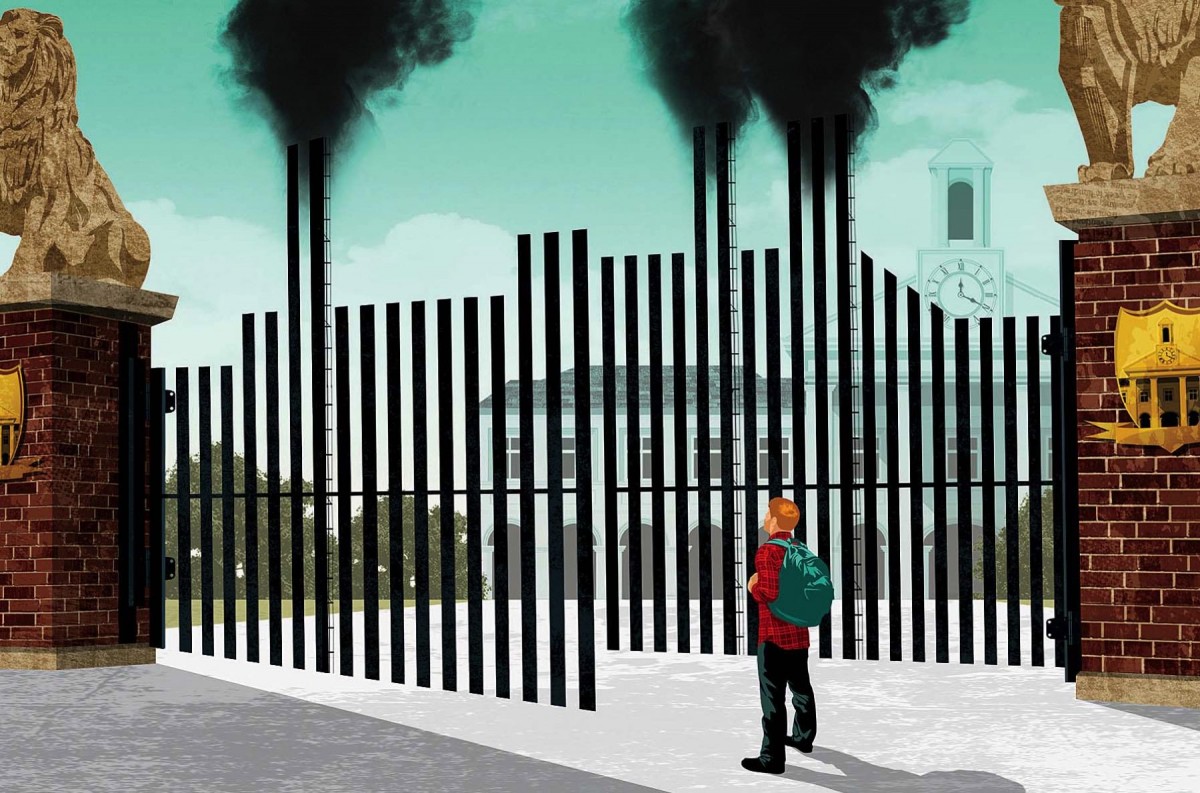
Illustration by Taylor Callery
Imagine how a white working-class student would think about these findings. Legacy preferences are the biggest slap in the face, because they give extra points to a competitor who already has enjoyed considerable educational advantage. (And research suggests legacy preferences don’t even boost alumni giving.) Similarly, consideration of race obviously doesn’t help white working-class students, and in fact tends to aid relatively advantaged minority students: Bowen and Derek Bok found in a seminal study that 86 percent of African Americans at selective colleges are middle or upper class. Is it any surprise that when a demagogue comes along and tells white working-class people that the system the elites have built is rigged against them, they follow him?
Progressive leaders used to know this. When faced with the question of how to remedy our nation’s history of discrimination, Martin Luther King Jr. said class-based policies would disproportionately benefit black people but would also be inclusive of lower-income whites. “It is a simple matter of justice,” he wrote, “that America, in dealing creatively with the task of raising the Negro from backwardness, should also be rescuing a large stratum of the forgotten white poor.” In addition, King was keenly aware of the politics of leaving out disadvantaged whites. He wrote: “It is my opinion that many white workers whose economic condition is not too far removed from the economic condition of his black brother, will find it difficult to accept a ‘Negro Bill of Rights,’ which seeks to give special consideration to the Negro in the context of unemployment, joblessness, etc. and does not take into sufficient account their plight (that of the white worker).”
I saw a beautiful manifestation of King’s vision—and Robert Kennedy’s political coalition—when I spoke last year at Harvard to a multiracial audience of first-generation college students from across the Ivy League and other selective institutions. The students, disproportionately African American and Latino, reflected the reality that race continues to affect economic status. But these students, who had impressively overcome odds, were fully allied with the white and Asian students in the audience, who also faced educational disadvantages. The group represented the very mix of students who had been pitted against one another in Boston’s busing crisis, but here they were, fighting for a common cause: raising the tiny numbers of economically disadvantaged students at top colleges.
The Stakes in 2017
The exclusion of low-income and working-class students from selective campuses has always been an issue of serious moral concern, but the 2016 election raised the stakes: we now face a genuine crisis in American democracy. The failure to provide more avenues of success for lower-middle-income whites has created an opening for America’s first presidential-level demagogue. And the failure to admit meaningful numbers of working-class whites to selective colleges has made it much more difficult for professors to understand an important and alienated swath of their own society. It is not a healthy thing for our democracy when many of America’s leading minds know much less about white working-class people than do white nationalists like Steve Bannon [M.B.A. ’85].
The heartening story of George Wallace voters turning to Robert Kennedy in 1968 has now been reversed, as a twenty-first-century version of Wallace—who attacked minorities, the press, and an independent judiciary—garnered the votes of some who had previously supported America’s first black president.
The irony is that the faculty neglect of white working-class people is likely to have the most devastating impact on the very racial and religious minorities whom elite faculty members do, to their credit, care about. Journalist Fareed Zakaria [Ph.D. ’93, LL.D. ’12] noted after the election that if the primary sin of the right is racism, the cardinal sin of the left is elitism. Robert Coles has shown it is possible to avoid both vices. Now, driven to the precipice, will the academy follow his lead?
